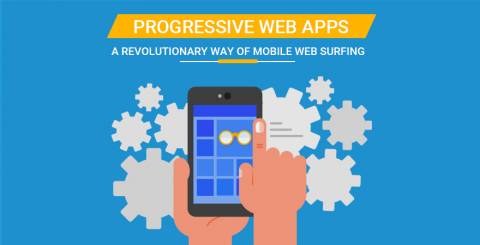Progressive Web Apps: A Revolutionary Way of Mobile Web Surfing

Once upon a time, there were two types of websites: slow and very slow. They used to take all the patience and time in the world just to open and I am not talking about a time when Internet itself was very slow. No. I am talking about the pre-PWA time, a time when online and offline was very much distinguishable.
Well, the scene might not have changed for every single website on the Internet landscape yet. However, some of the very well-known websites have taken it to what is known as Progressive Web Applications, PWA for short. Emerging as the latest buzz which experts believe to be staying and are not a fad or merely trends, PWAs have come with the features that are like win-win for both the company and the user.
PWAs Explained
Simply put PWAs are the apps that do not need a space on your mobile/desktop home screen and are perfectly happy to run on your browser in a look and feel that was once expected only from applications. With a variety of user-friendly features, they are known to engage users like they used to on the applications, may be better in many cases.
Developers are happy too as they now have to do less maintenance, only of a PWA of the website and not its three different versions: iOS, Android or desktop. PWA only needs a supporting browser to run irrespective of the gadget a user is employing for the surfing, making the life of the developers easy.
The background responsibilities for PWAs to run seamlessly on all the gadgets in any browser are delivered by Web App Manifests and Service Workers. Service Workers are the sophisticated bits of JavaScript executed from an HTML page to be running in background without letting the front user experience their presence. Web App Manifests are sort of master file containing metadata for related groups of a file.
The tech lingo can get some of you knocked overhead, so let’s get out of it and stick to the simple explanation that’s pretty easy to grasp since it’s visible and more importantly, experiential.
If you want to know why PWAs make for an attractive solution in just a few words, here are these:
- No hassle implementation
- Expand as needed (page-by-page / functionality-by-functionality)
- Supported and promoted by Google
Why PWAs are better than App or the regular website
The Progressive Web Apps have a series of features that allow them to perform a notch up than either from the apps or the good-old websites. Listed below are some of the key highlights as to why these are better than the both.
Why better than Apps
- No need to download
- No need to install yet allows saving a link in app-like form if the user prefers
- No need to take up space on the gadget
- No need to be developed separately for all the mobile platforms (Apple / Android)
- No need to distribute and promote separately since the website and app are married into one
- Offline mode works just fine by allowing saving of the pages user wishes to go back to
- No need to update manually which is not the case with the apps that need constant updating to fix bugs
- All the pages have their own URL so page-sharing is also easy, unlike regular apps
Why better than regular websites
- Works seamlessly on all types of browsers being progressive
- Being responsive by nature, the size of the gadget is not going to impact the look and feel
- Safety features are all inbuilt and not to be added later
- The functionality yet remains app-like and thus offers better user engagement and CTR, resulting in better Call-to-Action
- Made to be search engine searchable identified as app
- Users come back more often as push notifications don’t seem like an irritation to the user, thus better reengagement
- An app-like shortcut to the site can be placed on the homescreen if the user wishes to come here often
- Network issues are not really an issue if the user saves pages for later surfing
Benefits to the business
The businesses that choose to go with the PWAs are signing themselves for some great incentives. Have a look at some:
- Increased number of visitors / traffic
- Better response to applied Call-to-Action
- Enhanced user engagements promising better revenue generation opportunities
- Time spent gets increased (which generally translates into user understanding to better your service offerings and even customisation for every user)
- Better Click-Through-Rate
- Increased relevance to the users
- Get the users re-engaged through seemingly non-intrusive push notifications
- Better ROI if you see from the perspective of cost needed to develop PWA
Some of the effectively implemented PWAs
How a web development company can assist you in getting all the benefits mentioned above can be studied through the examples set by the following PWA versions of the websites (their respective companies have come up with):
- Twitter Lite
- Financial Times PWA
- Washington Post
- Flipkart
- Forbes
- Santa Tracker PWA
- AliExpress
Concerns on PWAs
As with everything, some areas of improvement or issues would always be there, no matter the list of pros. So is the case with PWAs as well. Listed below are some:
- Can’t replace native apps completely as of now due to the amount of accessibility a user has to the app and the app has on the user data
- iOS support is timid in comparison to Android, currently
- Marketing and distribution opportunity through the app store would be missed, sorely or not that is yet to see
Conclusion
The potential is great. The performance is promising. Concerns remain but that is for time to judge. The technology might evolve significantly before masses realize. All this is done because user / customer is still the king and reason that drives industry. Let’s see what’s rolling in next few months or a year or two!
Similar Articles
Compare hydraulic and traction residential elevators to find the best fit for your home. Learn how each system works, their pros and cons, space needs, energy use, and maintenance requirements.
Extend the lifespan of your commercial marina docks with proactive maintenance. Learn essential inspection routines, material-specific care, and safety tips to protect your investment and ensure long-term dock performance.
Learn the key factors in designing an engineered fall protection system. Discover how hierarchy of controls, task analysis, structural integrity, and fall clearance ensure safety and compliance.
Today, modern businesses face constant pressure to operate with maximum efficiency. This requires a technology infrastructure that is both agile and robust. However, the traditional model of on-premises data centers often has significant limitations. These legacy systems can drain valuable resources from teams.
When people are hungry, standing in line for a table feels tiring and unpleasant. In fact, research shows that most individuals will just walk away if they have to wait longer. They will go and find another place to eat.
In the early stages of designing new community centers, fire stations and administration buildings, city planners and architects are forced to make a crucial decision: What building material is best suited for providing the most value, safety and longevity to the public?
Amazon Simple Queue Service (SQS), Simple Notification Service (SNS), and EventBridge are just a few of the messaging services that AWS provides to meet various demands when it comes to creating scalable and effective cloud systems.
Wearable technology, embracing devices small enough to be worn unobtrusively, constitutes a market that keeps expanding, and the momentum shows little sign of slowing
For job seekers, grasping the basic functions of Applicant Tracking Systems (ATS) is the first step in overcoming common job search barriers.









